Although Mount Spurr’s eruption risk has lowered in recent weeks, scientists say Alaska’s iconic Volcano still poses a potential threat. Mount Spurr, located 78 miles southwest of Anchorage, has shown elevated seismic activity and ground deformation since last October.
Last month, the Alaska Volcano Observatory warned residents that an eruption could happen within weeks or months due to strong unrest signals. These included shallow earthquakes beneath the Volcano, visible snow melt at the summit, gas emissions, and mountain surface inflation.
Since then, earthquakes beneath the Volcano have decreased from January’s peak of 300 per week to about 70. Alaska Volcano Observatory scientist in charge Matt Haney said recent monitoring shows a slight reduction in volcanic activity, though it remains above normal.
During a Thursday update on the Volcano’s status, Haney explained that the ground deformation over the past three weeks had been deformation. Scientists believe the magma movement has reduced, although it has not stopped completely.
Haney added that weather conditions have disrupted efforts to collect crucial data from satellite and helicopter-based gas measurements. The lack of this data increases uncertainty about the Volcano’s exact behavior and future activity.
Mount Spurr is now under a yellow advisory alert, which signals ongoing elevated volcanic activity. If an eruption were to occur, it would resemble events from 1953 or 1992, when ashfall temporarily disrupted air travel and closed public buildings.
Scientists emphasize that Spurr typically gives early warning signs before erupting, including tremors and increased seismic activity. Emergency officials encourage the public to follow credible sources and avoid spreading misinformation online.
Travel and tourism across Alaska remain unaffected, and a new livestream is now monitoring Spurr’s summit from Glen Alps. Scientists expect improved weather to conduct essential gas emission surveys and update risk assessments this weekend.









